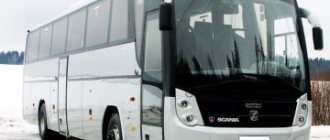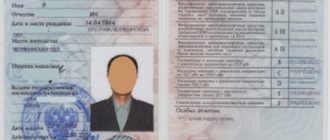Excursion tourism seems to be specially designed for bus tours. Today this type of travel is becoming increasingly popular. Comfortable long-distance buses allow you to enjoy the pleasure of learning new things while traveling. This type of transport is significantly different from city buses.
Long-distance buses are equipped with special soft seats with reclining backrests and armrests. They have a cavity for carrying passenger cargo, including shelves above the seats and a large space under the floor of the bus interior. The cabin itself may have not only a chemical toilet, but also a dispenser with cold and hot water, a mini-fridge, a TV screen and other devices to make the trip comfortable.
When choosing a bus for a long excursion tour, you need to take into account all these features and ask in advance how comfortable you will be on the road. Another important point is the safe location in the ADS cabin. When purchasing a ticket, the seats belong to the passengers in the same way as on the train, so they cannot be changed in the future. Seating layouts vary between buses.
Long-distance buses are a popular type of transport, so many different modifications of such vehicles are produced. In addition, the carrier has the right to independently equip the ADS cabin at its own discretion. Therefore, even buses produced at the same plant at the same time may differ in both the number of seats and their location.
In particular, the standard MAN tourist bus is designed to accommodate 59 seats, and the numbering starts from the first seat and from the right row. However, the MAN Lion's Coach R 08 modification has only 49 seats, while number one has a seat in the second row on the right. The first seats from the door are not numbered, as a result of which the last ones receive numbers 47 and 49.
The location of the seats on the MAN Lions Coach R 08 bus. The location of the seats on the MAN bus.
Such differences can be found in buses of all brands. For example, the small Mercedes 22360C is designed for 20 seats, and the numbering order is confused. The first seats 1 and 2 are located behind the driver, and the seats next to him are numbered 19 and 20. Further rows are numbered from right to left. Another bus from the same manufacturer, Mersedes-Benz 0303, is numbered from left to right and can accommodate 45 seated passengers.
Seat arrangement in Seat arrangement in the Mercedes-Benz bus 0303
bus Mercedes-22360C
The carrier can also change the arrangement of seats and equipment of the bus, for example, remove several seats, add a dry closet, or make room for office space. Depending on such innovations, the number and sometimes the location of passenger seats will change. Therefore, when buying a ticket, you need to carefully study the actual bus layout by asking the carrier for it.
Where is the safest place to sit on a long-distance bus?
Traffic safety is not the same for passengers occupying different seats on the bus. The same thing happens in passenger cars, where the safest place is considered to be behind the driver, and the most at risk is next to him. When purchasing tickets for ADS, you should look for a ticket for a seat located in the most secure area of the bus.
Here are some bus safety guidelines:
- The safest place is right behind the driver's seat. It is believed that when danger arises, the driver will subconsciously try to protect himself; accordingly, the opposite side comes under attack the fastest.
- The most comfortable and quiet places with a good level of safety are located in the center of the cabin. This zone remains the most intact both in a head-on impact and in a rear-end collision. Even in the case of a side collision, the impact can hit the rear, bypassing the middle.
- Seats on the right side of the aisle, rather than by the window, are considered safer than those on the left.
It is also useful to inquire about the safety of the passenger seats themselves. The safety rules in the cabin of an airplane also apply to a bus: do not walk around the cabin while moving, especially during maneuvers; in case of shaking or a dangerous situation, you must lean forward and hide your head on your knees.
Where is it better not to take the bus?
This information has not been confirmed by special scientific studies, but there are several types of seats where passengers really don’t like to sit:
- The last row of seats is notorious. This prejudice is quite logical, since the smell of burning and exhaust fumes is stronger here. The tail of the cabin moves more from side to side when moving and turning, and here there is more motion sickness. If you brake hard, you can fall into the aisle.
- The first row from the entrance and immediately behind the driver is also not popular. In a frontal impact, this part of the interior suffers the most.
When choosing a ticket, you should ask whether the seats recline. There may also be places in the cabin where the backrest does not move. A conscientious carrier will not sell them, but you should not hope for this; it is better to check in advance and ask the travel agent carefully. Most often, such seats are installed on the unloved last row or next to the door in the middle of the bus. The place next to the entrance has a number of features. In particular, it is coldest there in winter, but it is easy to get off first at any stop.
Penalty for excess passengers in 2022
Types of punishments for violating the procedure for transporting people in cars are prescribed in Art. 12.23 Code of Administrative Offences. The administrative fine for overloading is 500 rubles. It does not matter how many extra passengers are placed in the car - one or five - only one fine is issued. But it should be taken into account that they alone will not do. The traffic police inspector may also pay attention to:
- unbelted passengers - according to the rules, everyone must use seat belts if the car is equipped with them (in older models there are no belts in the rear seats, and only in this case the driver cannot be punished);
- transportation of passengers outside the cabin, and also collect 1000 rubles;
- violation of the rules for transporting children - in this case the penalty will reach 3,000 rubles.
If the vehicle being driven does not meet the parameters of the category indicated on the back of the license, a fine is issued for not having a driver’s license - up to 15,000 rubles. At the same time, the car is driven to the impound lot. What’s also important: recently, all fines have been added up. If previously, if there were several violations, only the largest fine was paid, now the driver is obliged to pay everything.
If you have recently graduated from a driving school, please note that when driving you can only follow the rules of the road. It doesn’t matter what is written on the license or what capabilities the car you choose has. The traffic police officer will not pay attention to this when he records a traffic violation, and in this case a fine cannot be avoided.
Important
When purchasing tickets, the details of seating in the cabin are not indicated. You can find out all the details about a particular bus from a travel agent, and for a conversation it is better to come to the company’s office in person. There they will be able to show you exact bus diagrams, seat layout plans, and tell you about what they would prefer to keep silent about when placing an order online.
When buying tickets, regulars of bus tours first of all pay attention to the location of the seats. Why is it important? Let's explain with an example.
Imagine that you have been planning your trip for a long time, thought through the route, and chose what you thought was a good place - with an excellent view, in the middle of the bus, not far from the door. And then it turned out that it was almost the only one that did not fold out. Everything would be fine, but only when the passengers in front reclined their seats did you find yourself squeezed on both sides. As a result, what was dreamed of as a wonderful journey turned into torture.
We will tell you in the article about all the nuances that you need to take into account when choosing a seat on the bus in order to avoid getting into a similar situation.
What should minibus drivers pay attention to?
When purchasing a minibus, pay attention to the number of installed seats. If there are more than 9 of them (including the driver’s license), you will not have a license to drive a car, even with 8 passengers, even without them. The information on the ID states the number of seats, not the actual number of people. Therefore, if you have mastered category B, how many seats are in the car and its other characteristics must strictly fit within the framework prescribed in the traffic rules.
The same rule applies to passenger cars where no more than 4 passengers can be carried. Traffic rules are a key guide to action that requires strict adherence. It doesn't matter what's on your driver's license. By violating traffic rules, you incur a fine, and in some cases even deprivation of your license.
Long distance buses - good and different
If you think that knowing the seat number is enough to understand how comfortable it is, you are deeply mistaken. The fleet of modern long-distance buses (LDBs) is so diverse that until you see the layout of the interior, it is premature to draw conclusions.
For example, you got seat number 14. In a tourist MAN with 59 seats, this is the beginning of the cabin, 4th row; but in the cabin of the same model with 45 seats, seat No. 14 is located in front of the door and, most likely, does not recline. In a 20-seater Mercedes, the same number 14 is located on the left by the window at the end of the cabin, and in a 45-seater it is on the right by the aisle, 4th row. And a lot of such examples can be given.
Even the typical diagram of a specific model is not always accurate, since the carrier has the right to make design changes - add a bathroom, a kitchen, remove some of the seats (for example, the back row), and equip a sleeping or cargo compartment.
Site selection criteria
As we know, there is no dispute about tastes, so everyone may have their own criteria for choosing a convenient place. Experienced tourists recommend first of all taking into account such parameters as:
- safety;
- arrangement of seats in relation to the door;
- cabin segment (beginning, middle, end).
Let's look at them in more detail.
Dangerous and safe
Reports of road incidents involving ADF appear with alarming frequency, making it every traveller's No. 1 priority to reach their destination in one piece.
What places are potentially dangerous?
- First row, especially to the right of the aisle. In a head-on collision, they are the first to be hit.
- The last row may be damaged if the impact comes from behind. In addition, during sudden braking, rear row passengers have a higher risk of injury by flying into the aisle.
- Armchairs by the window on the left side of the cabin. We drive on the right side, so this side of the bus is always turned towards the flow of traffic.
The safest seats on a long-distance bus are as follows.
- In the middle of the cabin on the right side. But even in this relatively safe zone, it is better to sit not by the window, but near the aisle.
- The seats are immediately behind the driver. It is believed that the driver, instinctively avoiding danger, removes this zone from the impact, and, on the contrary, exposes the right side.
“Insidious” – next to the door
Places located in close proximity to the door are especially “tricky”.
If they are behind it, in winter and autumn, this is a zone of cold air currents that hit passengers every time the door opens. By the way, in summer the influx of fresh air can rather be considered a plus.
If the seats are on the right side in front of the door in the middle of the cabin, they do not recline. This is designed so as not to interfere with people getting off at stops. Typically, such seats are cheaper, but passengers do not always fully understand the reason for the bonus.
The area next to the door is not without its merits. You will be the first to get off the bus at the parking lot, which means you will get to the buffet, toilet, or just have time to smoke faster.
Disadvantages of the back rows
Few people like the last row in the ADF. And there is good reason for this.
- It shakes more violently here, and people with seasickness get seasick.
- The backs of the seats do not recline, which means there is no opportunity to relax or take a nap.
- If you use a general air conditioner rather than a climate control system to cool the air, it blows strongly from behind.
- If there is only one TV, you cannot see or hear it from the back row. The same goes for a guide during an excursion.
Some tour operators usually sell two tickets for the last row of 5 seats. Then their owners will have the opportunity not only to sit down, but also to lie down fully.
Features of choosing a seat on a double-decker bus
A travel agency may offer you a trip on a double-decker bus. This vehicle has a different seat layout and its own characteristics.
To decide which is best for you, study the pros and cons of each floor.
Advantages of the first floor:
- spacious interior;
- there are fewer people than at the top;
- comfortable tables;
- Nearby there is a bathroom, kitchen, water cooler, refrigerator.
Of the minuses
The cabin is located low in relation to the road, so you won’t be able to admire the panoramic views.
Be prepared for drivers to continue chatting in the evening, and perhaps listen to music or watch a movie.
Advantages of the second floor
- magnificent panoramic view;
- Quiet in the evening, because the drivers are below.
There are also disadvantages
It is more cramped here than on the first floor, which will be especially felt by tall and obese passengers.
Be prepared to descend each time to use the facilities or during stops. The second floor is not for people with disabilities.
And instead of a conclusion. Having chosen a place you like, make sure that it is officially indicated in the voucher (everything is clear with the ticket), otherwise it will turn out like in that joke - whoever gets up first gets the slippers.
This article will talk about seats on the bus. We'll talk about which ones are best to choose in order to feel safer, and which ones are best to ignore so as not to ruin your trip. Let's also consider the diagrams of various buses.
How many passengers are allowed to carry with category B?
Resolution No. 1097, which came into force on November 24, 2014, is still in effect. It determines what characteristics a vehicle driven by a driver with a category B license should have:
- total weight - up to 3500 kg;
- number of passenger seats - 8, including the driver's seat - 9;
- with a trailer weighing up to 750 kg;
- with a trailer weighing over 750 kg, provided the total weight of the vehicle is no more than 3.5 tons.
Almost all representatives of crossovers, hatchbacks, sedans, minivans, jeeps, and minibuses fit into the listed requirements. However, it must be taken into account that there are models on the automotive market that go beyond the scope. For example, twelve-seater minibuses are not uncommon, but driving them requires a category D license. Accordingly, if your driver’s license contains category B, the total number of seats for passengers in the car should not be more than 8.
Seats on long-distance buses
Transporting people over long distances occupies a special niche in passenger transportation. It should be noted that tourist tours, which often use large-capacity vehicles, are separate. The location of the seat on the bus, the layout of which can change with different vehicle capacities, can largely determine the comfort and safety of the trip. As a rule, the passenger's seat is reserved until the end of the trip, so you need to be very responsible about his choice.
What types of minivans are there?
Minivan-type cars have a fairly simple classification associated with body length:
- Cars longer than 4.6 m are considered large. They appealed to wealthy American car enthusiasts;
- compact ones have a length of 4.2 to 4.6 m. They have not taken root in America, but in Europe and Japan they are found quite often;
- mini is even more compact and more economical in terms of gasoline consumption. Also popular in European and Asian markets;
- micro is a category in which all dimensional parameters of minivans are subject to restrictions. Length - less than 3.4 m, width - less than 1.475 m, height - up to 2 m. The sales rankings are topped by China and India.
According to another classification, they differ in:
- compact vans (created on the basis of compact class cars);
- microvans (budget single-volume vans with two front doors, two sliding doors and a rear door);
- multivans (have a transformable interior for transporting goods).
Seats on buses - location
In the fleets of travel companies and enterprises involved in transporting people over long distances, there is a wide variety of car models. There is no single seat position on a bus, the layout of which would be common to all manufacturers. Manufacturers, as well as transportation companies, can equip vehicles at their own discretion, as long as they do not violate the safety requirements regulated by regulatory documents. Even single-brand buses produced in the same year may differ in both interior design and number of seats. To the question: “What is the location of the seats on the bus, what does the layout inside look like?” The answer is only approximate.
Before purchasing a ticket, you should check with the carrier about the seat layout.
In addition to convenience, you should consider safety, which determines the choice of the right place.
Safe places
News feeds often talk about road accidents involving passenger vehicles. Therefore, careful selection of the location of the seat on the bus, the selection scheme of which is discussed below in the text, will directly affect the safety of your life.
For a safer trip, you need to consider the following points:
- one of the safest places is the one located behind the driver’s seat;
- you should choose seats located in the center of the cabin;
- It is better to choose seats installed on the right side.
The following places can ruin your trip:
- The last seats, because in this part, as a rule, there is a lot of burning, and after a certain period of time there is a risk of getting poisoned by exhaust fumes. Riding in the rear leads to more severe motion sickness, and during emergency braking there is a risk of flying into the aisle between the seats.
- Seats located next to the door or driver.
- Non-folding seats, usually located at the end, as well as in front of the exit, in the middle of the cabin.
How to protect yourself from injury in an accident
Even a reliable Mercedes does not always help passengers out, but when driving a minibus with an experienced driver at the wheel at speeds of up to 60 km/h, accidents with serious consequences can be avoided. If you managed to take a safe place in the cabin, when pushing, you need to firmly grasp the handrail of the seat in front to prevent hitting your head. When standing in a minibus, it is advisable to sit with your back forward, remembering to hold on. Evenly distributing your weight on bent legs will help you regroup and soften the blow.
Examples of seat placement
The photo below shows the location of the seat on the bus. The layout of 47 seats is typical.
This scheme is typical for the following brands: Higer KLQ 6119 TQ, YUTONG 6129.
The next photo also shows the location of the seat on the bus (diagram). 49 seats is a fairly common option.
The scheme is typical for the following brands: Higer KLQ6129Q, Neoplan 1116 Bus, Setra 315.
Minibuses Mercedes Sprinter
manufactured in Nizhny Novgorod are supplied to the Russian market with different configurations and capacities. The most common models are cars with a capacity of up to 27 people. The capacity formula in this case is 19+7. It stands for this: 19 seats and 7 passengers can ride standing. For this purpose, the interior is equipped with handrails, thanks to which you can safely ride while standing in the minibus.
Minibus configurations may differ in the number of seats, as well as their layout. They can be installed both in the direction of movement and in different directions. For example, for the transportation of tourists, the arrangement of seats in the direction of travel is suitable, since such routes usually run over fairly long distances, and passengers should feel comfortable.
For companies organizing wedding transportation, the most suitable cars are those in which some of the seats are located opposite each other. This is convenient when guests sit opposite and can easily communicate with each other. And for minibus taxis, it is most profitable to take cars that can accommodate the maximum number of passengers.
Reasons for the popularity of high-capacity cars
The demand for minivans on the market is quite explained by their user advantages:
- the car body is designed for 7–9 seats, including the driver's seat. In addition to the seats, usually arranged in three rows, there is a spacious luggage compartment;
- the rear row seats can be folded, which will significantly increase the volume of transported items, making it possible to transport even large luggage;
- The interior is spacious, so passengers feel relaxed and comfortable on the road. On a long journey, the high position of the seats takes on special meaning, allowing you to admire the beauty of the area.
Why should you choose a minivan if, for example, you are planning a picnic on a holiday weekend or are going to organize an excursion for your company's guests? In the family or business transportation category, these vehicles top the popularity charts. Ideally suited to the urban rhythm of life, they are designed for travel, group outings and excursions. Users highly value the maneuverability, comfort, and convenient layout offered by minivans.
How to buy a Mercedes Sprinter minibus profitably
In our showroom it is profitable to buy a Mercedes Sprinter minibus
possible at almost any time. We regularly hold promotions and offer various seasonal gifts upon purchase. For example, when you buy a car in the fall or winter, you can get a set of winter tires. And in the summer there is air conditioning. These are simply irreplaceable things that make driving more comfortable for the driver and passengers.
Tourist buses can be additionally equipped with speakers and a microphone. With the help of which, the guide will be able to tell tourists about the sights they pass, their history and other educational and interesting things.
Our organization strives to make everything as convenient as possible for our clients. We will install additional equipment on your new minibus, which will make traveling or transporting tourists much more comfortable and enjoyable. A minibus is a fairly large car; you can install an excellent stereo system in its interior. This offer will appeal to companies that purchase a Mercedes minibus.
for personal use. Traveling with music is so much more fun!











